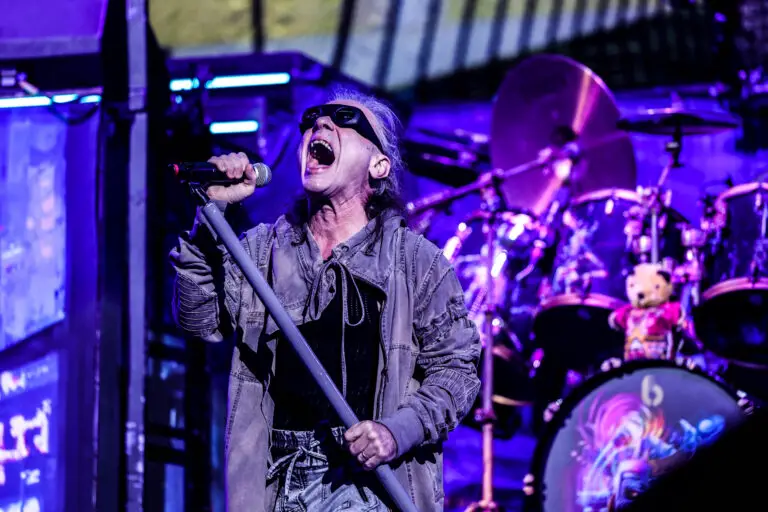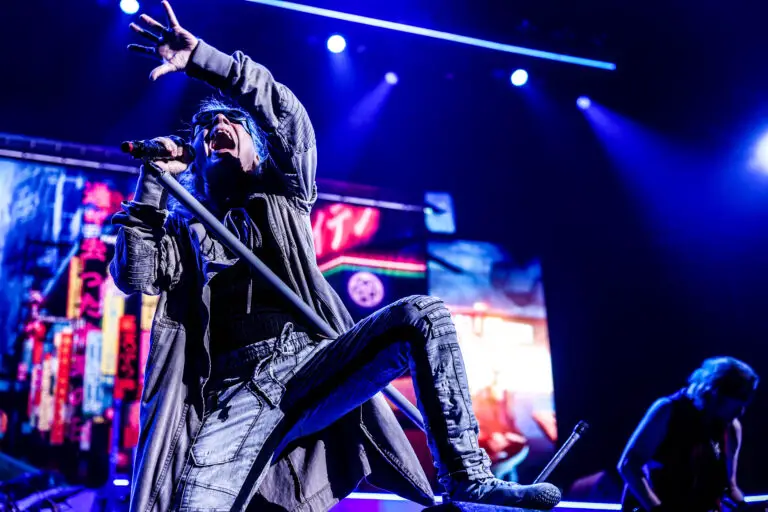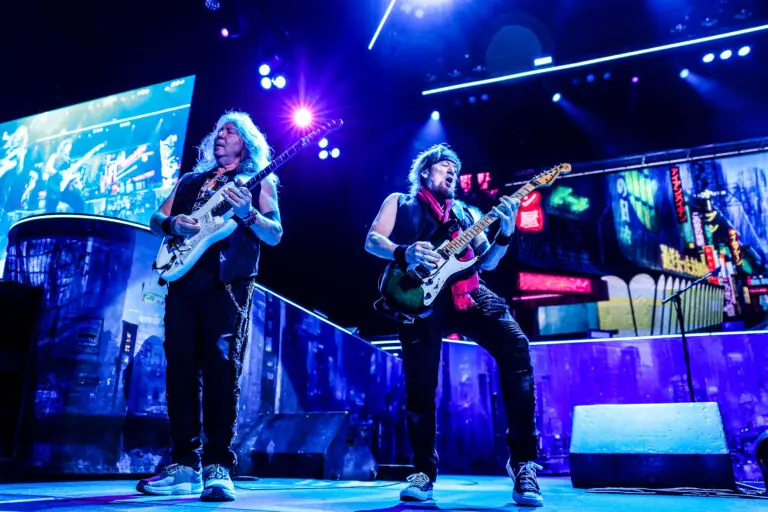In the 1980s, Iron Maiden led the charge in the New Wave of British Heavy Metal movement, guiding heavy metal music into a resurgence in popularity. A younger generation of hard rock fans embraced Iron Maiden and other NWOBHM bands that injected the intensity of punk rock into the more polished heavy metal sound of the 1970s.

As impactful as that new genre of music became in the 1980s, few bands survived beyond that era. Decades later, Iron Maiden still rules the heavy metal world. Forming in 1975 in London, England, Iron Maiden reached its widest mainstream appeal with a series of platinum albums and arena-headlining tours in the 1980s. Perhaps indicating another possible resurgence, the band’s 17th and most recent album, Senjutsu, recorded in 2019 and released in 2021, proved to be Iron Maiden’s highest-charting album in the United States.
Senjutsu (Japanese: 戦術, “Tactics”) was the band’s first album of new songs in six years. Despite fluctuating record sales, Iron Maiden’s tours have maintained high drawing power. Part of the success of the band’s tours in the 2000s was the return of vocalist Bruce Dickinson and guitarist Adrian Smith to the fold in 1999. Since their return, Iron Maiden stabilized as a sextet, with founder and bassist Steve Harris, guitarists Dave Murray and Janick Gers, and drummer Nicko McBrain, who is touring despite suffering a stroke in January 2023.

The latter part of Iron Maiden’s The Legacy of the Beast World Tour in 2022 introduced audiences to three songs from Senjutsu, but the overall setlist was largely a retrospective repertoire. The current The Future Past World Tour, which began in Europe in 2023 and will end this December in South America, includes five songs from Senjutsu, five songs from 1986’s Somewhere in Time, and five other songs, mostly from the 1980s. Fan favorites like “Run for the Hills” were omitted on this tour.
At Barclay Center, as at other tour stops, the house music blasted at 8:50 p.m. with UFO’s “Doctor Doctor,” followed by Vangelis’ instrumental “End Titles” from the 1982 science fiction film Blade Runner. Indeed, the graphics of the stage setting soon referenced the futuristic cyberpunk style associated with that film. The center back of the stage showed two animated videos of Iron Maiden’s mascot, Eddie the Head, the cyborg version on the left and the samurai on the right. Within seconds, a center panel revealed an artistic rendition of a barren, dystopian-looking city street in Japan in the dark of night.

The musicians began the synthesized bass and guitar introduction of “Caught Somewhere in Time,” the opening track from the 1986 album, Somewhere in Time. The front line of Harris, Smith, Murray and Gers immediately made use of the entire stage, pacing everywhere as they played their instruments. Wearing dark goggles and an open calf-length coat, Dickinson ran onto the stage, spun his microphone stand high above him, and added to the high energy. The now-standing audience sang loudly to the repetitive one-line chorus.
Dickinson was remarkable on stage. The 66-year-old’s soaring, operatic-style vocals were remarkably strong and brilliantly clear, especially considering that he has survived bouts of cancer on his tongue, neck and throat. He also moved amazingly well, continuously leaping across the stage, thanks to a recent hip replacement and five and a half inches of titanium hammered into his femur. Iron Maiden’s three-guitar structure extended nearly every song to showcase the talents in the band. Flighty solos, harmonious twin and triple guitar leads, and even a few brief duels superbly filled out the songs. Several times, Dickinson took advantage of these interludes to walk offstage and change his wardrobe.

In addition to all the futuristic visuals that accompanied Iron Maiden’s music, a 10-foot-tall Eddie made three appearances. The creature’s first cameo was during the second song, “Stranger in a Strange Land.” Appearing as a cyborg, parts of his internal musculature were exposed and his eyes glowed bright under his cowboy hat. Eddie returned to the stage during “Heaven Can Wait” and engaged with Dickinson in a gun battle, illuminated by pyrotechnics. Eddie’s final cameo was during the song “Iron Maiden,” in which he appeared as a samurai, threatening Gers with a giant katana sword.
Iron Maiden concluded the main set with the song “Iron Maiden,” which was recorded when Paul Di’Anno was the lead singer. Di’Anno died this past October 21 at age 66. The cause of death has not been disclosed, but he suffered health issues in recent years that restricted him to performing in a wheelchair. The band returned on stage for a three-song encore. The musicians and their fans maintained the same high level of energy for two hours. As the musicians took their final bows, a recording of the Monty Python song, “Always Look on the Bright Side of Life,” played through the arena’s speakers, finally reducing the temperature of the event.

Iron Maiden is far from finished. Although the band has no plans for recording new music between now and then, Iron Maiden this past September announced its next tour. The Run for Your Lives world tour will begin in May 2025 in Budapest, Hungary. The tour will celebrate Iron Maiden’s 50th anniversary with an elaborate stage show and a setlist comprised of selected songs exclusively from the band’s first nine albums, from 1980’s Iron Maiden to 1992’s Fear of the Dark. American dates have not yet been announced.
Iron Maiden – Barclays Center, Brooklyn – Saturday, November 2, 2024
Setlist: Caught Somewhere in Time, Stranger in a Strange Land, The Writing on the Wall, Days of Future Past, The Time Machine, The Prisoner, Death of the Celts, Can I Play with Madness, Heaven Can Wait, Alexander the Great, Fear of the Dark, Iron Maiden, Hell on Earth, The Trooper, Wasted Years
Photography by Ehud Lazin

































Comments are closed.